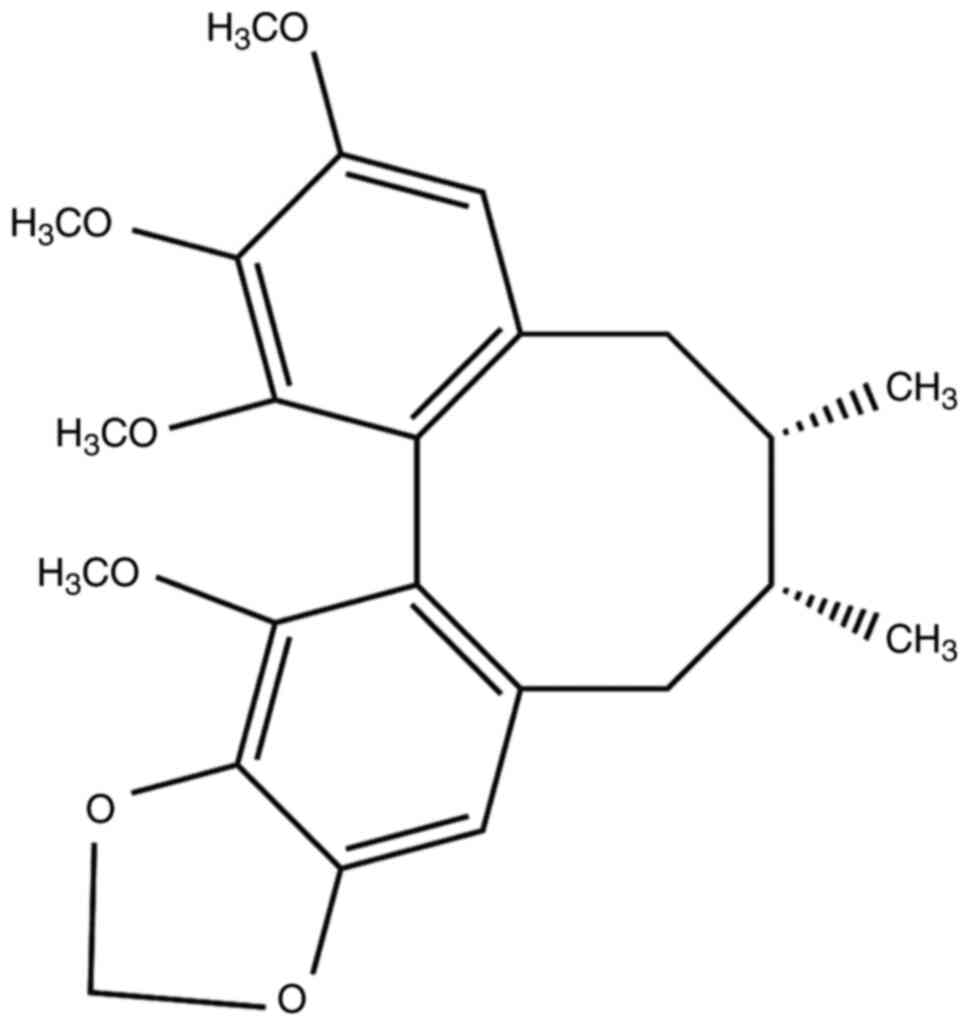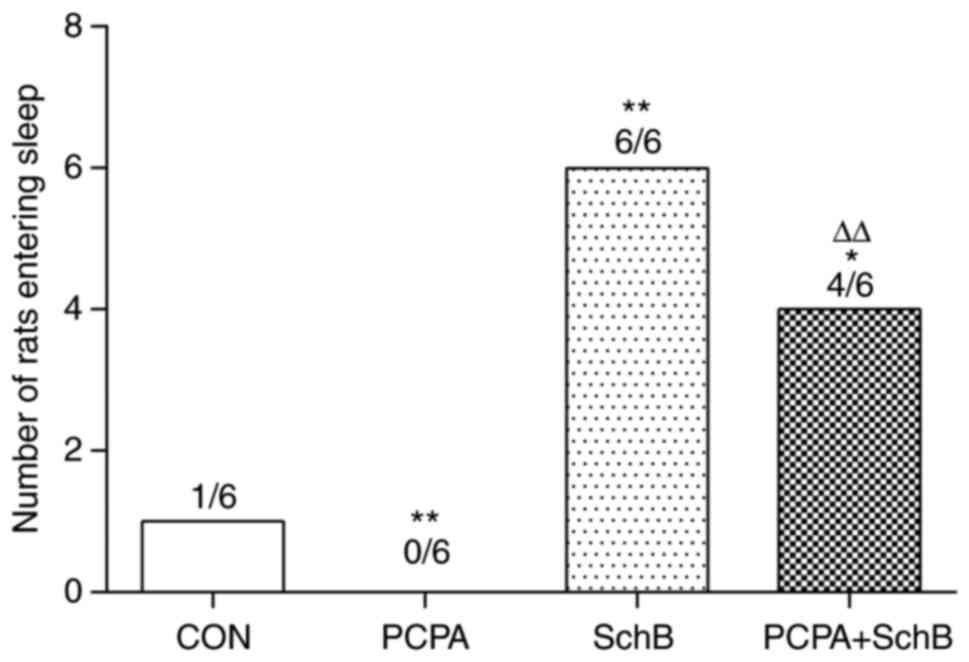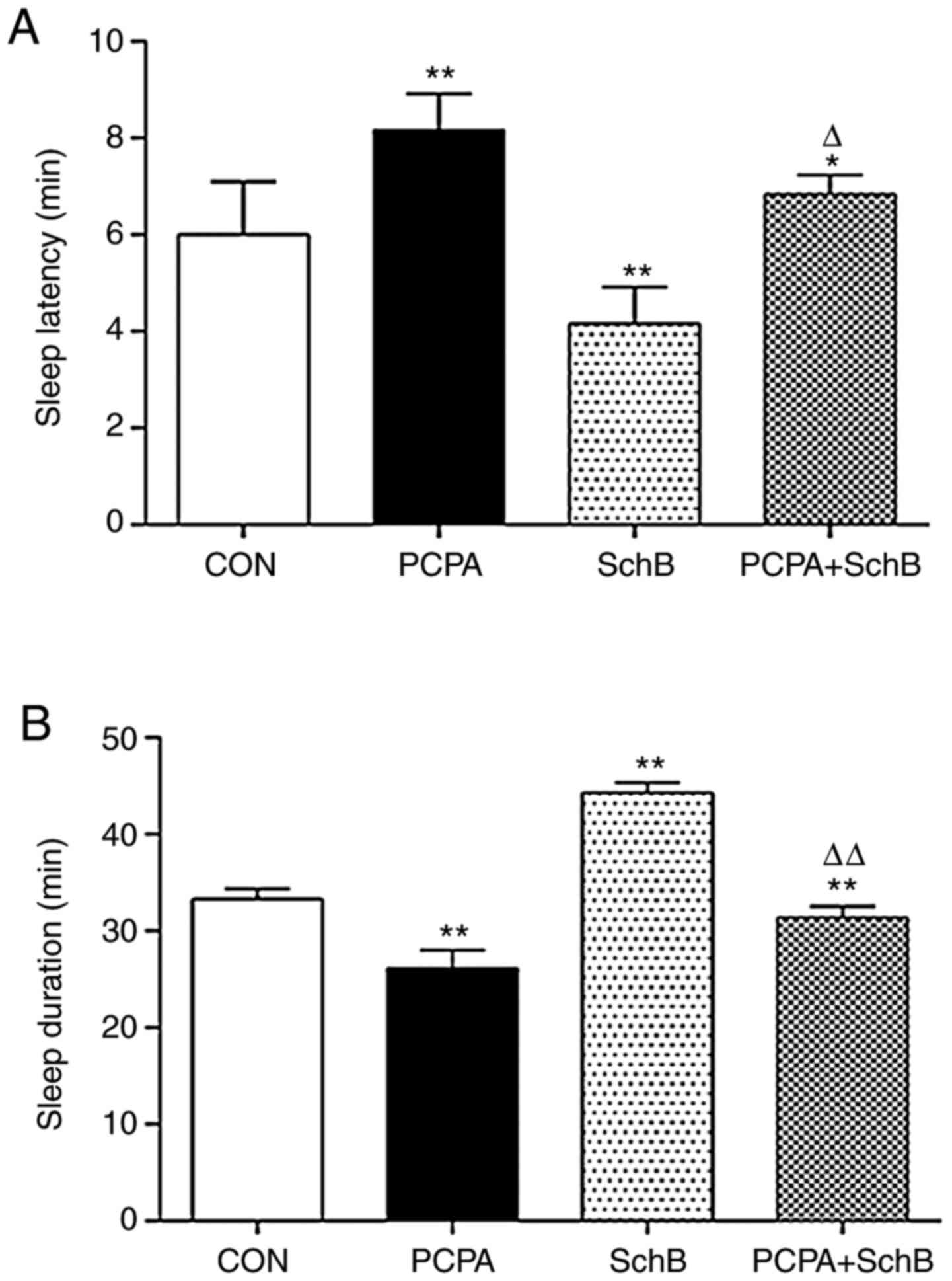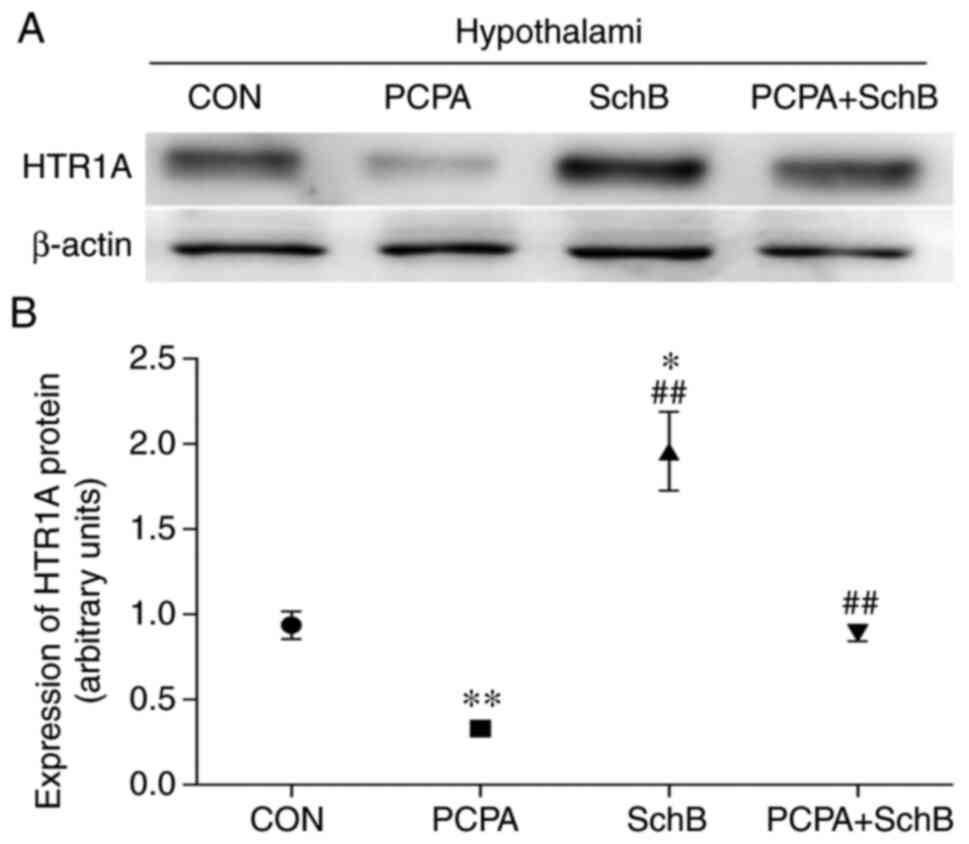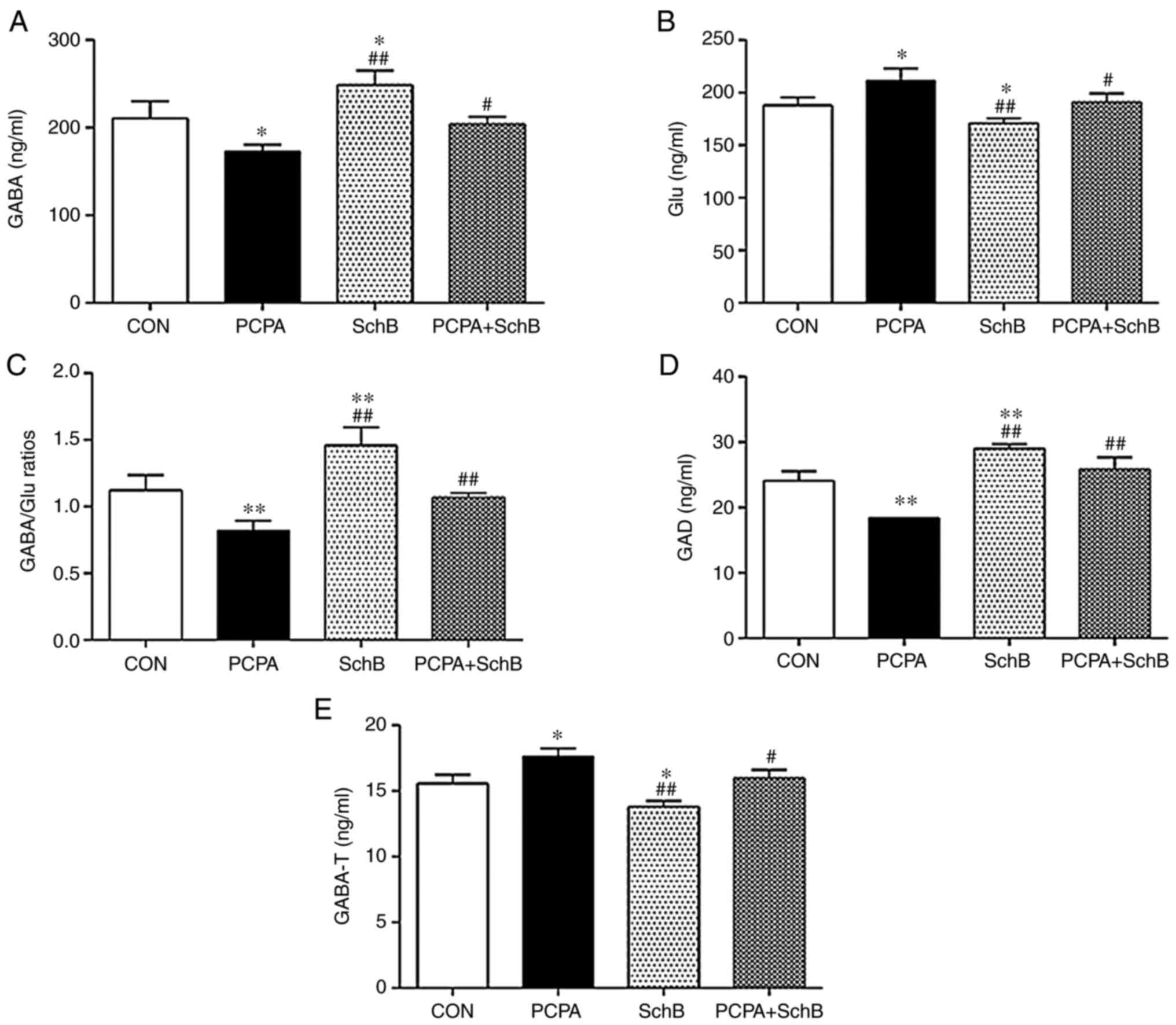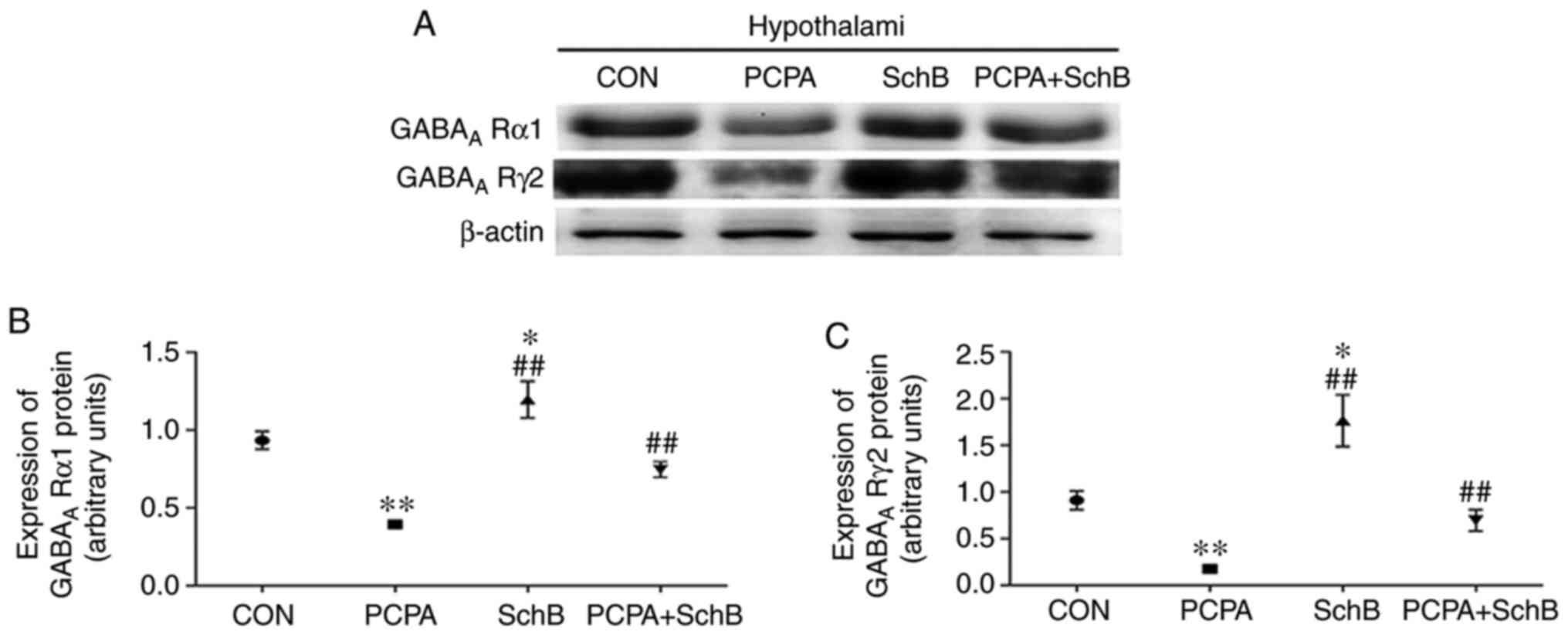Schisandrin B exerts hypnotic effects in PCPA‑treated rats by increasing hypothalamic 5‑HT and γ‑aminobutyric acid levels
- Authors:
- Published online on: October 5, 2020 https://doi.org/10.3892/etm.2020.9271
- Article Number: 142
Abstract
Introduction
All species maintain a 24-h solar cycle of rest and activity, and disrupting this cycle affects adaptation and homeostasis (1). Similar to fish that do not sense the water except if they are placed in a dry environment, the quotidian normality of sleep is not perceived until it is disrupted (1). For example, 30% of the adult population complain of transient insomnia, and 10% experience chronic insomnia that disrupts daytime function (2). Patients with chronic insomnia experience low work productivity and a high number of absenteeism incidents, accidents and hospitalizations, resulting in treatment costs of 60 billion dollars annually (3). Schisandra, a Traditional Chinese Medicine, is the dried ripe fruit of Schisandra chinensis (Turcz.) Baill. (Magnoliaceae), and has been used to treat insomnia for hundreds of years (4,5). Schisandrin B (SchB) is a monomeric compound of Schisandra lignans (Fig. 1). According to a previous study in rats, SchB exerts sedative and hypnotic effects, which are associated with the upregulation of the inhibitory neurotransmitter γ-aminobutyric acid (GABA) and both the mRNA and protein expression of its two receptors, GABAA receptor α1 (GABAA Rα1) and GABAA receptor γ2 (GABAA Rγ2) (6). However, reports have demonstrated that as well as GABA, 5-hydroxytryptamine (5-HT), another central neurotransmitter, also plays an important role in sleep regulation (7,8). The decarboxylation of 5-hydroxytryptophan, a 5-HT precursor, is a key step during the synthesis of 5-HT, and the tryptophan hydrogenase enzyme is essential for this step (9). Parachlorophenylalanine (PCPA) can antagonize tryptophan hydrogenase and inhibit the synthesis of 5-HT, resulting in insomnia with less slow wave sleep and circadian rhythm disturbances (10,11). Therefore, in the present study, a PCPA-induced insomnia rat model was used to determine whether SchB exerted its sedative and hypnotic effects by regulating 5-HT. The study aimed to provide experimental evidence for further development of SchB as a sleep-promoting supplement and medicine.
Materials and methods
Chemicals and reagents
SchB (Chengdu Pukang Biotechnology Co., Ltd.), the crude powder of Schisandra sphenanthera Rehd. et Wils, was added to 10X the volume of ethanol and extracted three times for 1 h each. The combined filtrate was then concentrated to a small volume, and the sample was mixed with diatomite and extracted three times with n-hexane-ethyl acetate at a 10:1 ratio; the filtrate was then concentrated once more. The sample was mixed with silica gel for gradient elution with petroleum ether-ethyl acetate (1:0-5:1), and the sample fraction containing SchB was collected and concentrated until dry, and then dissolved in anhydrous ethanol at 4-10˚C until crystallization. After repeated recrystallization with anhydrous ethanol (2-3 times), the purity of SchB reached >98%. PCPA was purchased from Sigma-Aldrich (Merck KGaA), and rat GABA, glutamate (Glu), glutamic acid decarboxylase (GAD), γ-aminobutyric acid transaminase (GABA-T), 5-HT and 5-hydroxyindoleacetic acid (5-HIAA) ELISA kits were purchased from Zhongsheng Beikong Biotechnology Co., Ltd. (http://www.zhongsheng.com.cn/). GABAA Rα1 (1:1,000; cat. no. ab252430) and GABAA Rγ2 (1:1,000; cat. no. ab87328) were acquired from Abcam. 5-hydroxytryptamine receptor 1A (HTR1A; 1:1,000; cat. no. A2801), β-actin (1:100,000; cat. no. AC026) and HRP goat anti-rabbit IgG (H+L) (1:5,000; cat. no. AS014) were acquired from ABclonal Biotech Co., Ltd. All antibodies were diluted with TBS with containing 0.1% Tween-20 (TBST).
Experimental animals
A total of 52 eight week-old male Wistar rats, weighing 200±10 g, were provided by Changchun Yis Experimental Animal Technology Co., Ltd., license no. SCXK (Jilin) 2016-0003. The animals were maintained in separate cages in a quiet environment at 18-22˚C and 50-60% humidity with a 12-h light/dark cycle and under specific pathogen-free conditions, with free access to food and water, and were acclimated to the laboratory environment for 7 days before experimentation.
Animal grouping and treatment
For reproduction of the insomnia model, rats were maintained for 1 week and then intraperitoneally administered with PCPA (300 mg/kg) once a day for 3 days. The disappearance of the circadian rhythm and continuous animal activity during the day indicated successful model establishment.
For sleep behavioral experiments, 24 male Wistar rats were randomly divided into the blank control (CON), model (PCPA), SchB, and PCPA + SchB groups (6 rats per group). Rats in the CON and PCPA groups were administered equal volumes of distilled water, and those in the SchB and PCPA + SchB groups received 3.5 mg/kg SchB once a day for 7 days. In our previous research, we observed the sedative and hypnotic effects of SchB in mice at an effective dose of 5 mg/kg (6). Based on this, we calculated the equivalent dose of 3.5 mg/kg for rats, which was effective in the preliminary experiment. So, 3.5 mg/kg SchB was selected as the appropriate dose in the present study. Following the sleep behavioral experiments, the rats were anesthetized with ether, as it is easy to evaporate using a simple device, rarely causes animal death due to overdose, and has no effects on the experimental data. The status of anesthesia was judged by falling, relaxed limbs and loss of the skin pain reflex. The presence of a heartbeat and breathing confirmed that the rats were alive. The rats were sacrificed by exsanguination from the abdominal aorta under ether anesthesia for 10 min (12). The animal experiments were approved by the Institutional Animal Care and Use Committee of Beihua University (approval no. 20190301).
A total of 28 male Wistar rats (grouped and treated as aforementioned; 7 rats per group) were used for the detection of biomarkers associated with sleep regulation. The rats were sacrificed by exsanguination from the abdominal aorta after 10 min of ether anesthesia. The hypothalamus was then removed from the brain tissue, homogenized, and separated to harvest the supernatant. The levels of 5-HT, 5-HIAA, GABA and Glu, as well as the activities of GAD and GABA-T in the rat hypothalamus were determined by ELISA. Protein expression of HTR1A, GABAA Rα1 and GABAA Rγ2 was detected by western blotting.
Sleep experiments for the synergistic effects of SchB and pentobarbital sodium
On the 7th day, 40 min after the last administration of SchB, the rats in all four groups were intraperitoneally treated with a subthreshold dose of pentobarbital sodium (28 mg/kg), and the number of sleeping rats was observed. After another two days, the rats received a threshold dose of pentobarbital sodium (35 mg/kg) to distinguish sleep latency and duration. At 30 min post-pentobarbital sodium administration, the number of sleeping rats (determined by the disappearance of the righting reflex for >1 min), the sleep latency (the time from the start of administration to the start of sleep) and the sleep duration were observed.
Detection of 5-HT, 5-HIAA, GABA and Glu levels, and GAD and GABA-T activity in the rat hypothalamus
On the 7th day, 40 min after the last administration of SchB, the rats were anesthetized with ether and sacrificed by exsanguination from the abdominal aorta. The hypothalamus was rapidly isolated on ice, homogenized and separated to generate the supernatant. 5-HT, 5-HIAA, GABA and Glu levels, as well as the activities of GAD and GABA-T were detected by ELISA kits (5-HT, cat. no. 201506; 5-HIAA, cat. no. 201506; GABA, cat. no. 201512; Glu, cat. no. 201512; GAD, cat. no. 201512; and GABA-T, cat. no. 201512) from Zhongsheng Beikong Biotechnology Co., Ltd. (http://www.zhongsheng.com.cn/), according to the manufacturer's instructions.
Western blot detection of HTR1A, GABAA Rα1 and GABAA Rγ2 protein expression in the rat hypothalamus
The hypothalamus of each rat was immersed in lysis buffer (protein lysate; Beijing Solarbio Science & Technology Co., Ltd.) on ice for 1 h, and the supernatant was separated by centrifugation at 16,000 x g and 4˚C for 10 min. Protein concentration was determined using the BCA method, and the target proteins (60 µg per lane) were separated via SDS-PAGE on a 10% gel, and subsequently transferred to PVDF membranes for 2 h. The membranes were rinsed with Tris buffer for 5 min, and then blocked with blocking buffer (TBST buffer containing 5% skimmed milk powder) for 1 h at room temperature. The blocking buffer was discarded, and the corresponding primary antibodies were added and incubated at 4˚C overnight. The membranes were washed with TBST five times for 5 min each time, and incubated for 2 h with the corresponding secondary antibodies. The membranes were washed with TBST five times (5 min each) and were visualized using the enhanced electrochemiluminescence method. ImageJ (version 1.51j8; National Institutes of Health) was used to perform the western blotting densitometric analysis.
Statistical analysis
SPSS 20.0 software (IBM Corp.) was used for all statistical analyses. All quantitative data are expressed as the mean ± SD, the mean value is taken from each rat in each group treated with or without SchB. The data between the two groups were compared using one-way ANOVA (followed by Tukey's test). Each assay was performed in three experimental repeats. P<0.05 was considered to indicate a statistically significant difference.
Results
Effects of SchB in combination with a subthreshold dose of pentobarbital sodium on the number of sleeping rats
To evaluate the hypnotic effects of SchB, a sleep experiment was performed on rats treated with a subthreshold dose of pentobarbital sodium. As shown in Fig. 2, the number of sleeping rats in the SchB group was significantly increased compared with that in the CON group (P<0.01), indicating the hypnotic role of SchB. Compared with the PCPA group, the number of sleeping rats in the PCPA + SchB group was significantly higher (P<0.01), suggesting that SchB and pentobarbital sodium exerted a synergistic effect to induce sleep in rats.
Effects of SchB in combination with a threshold dose of pentobarbital sodium on sleep regulation in rats
The effects of SchB in combination with a threshold dose of pentobarbital sodium on sleep latency and duration were observed in rats. The results indicate that compared with the CON group, the sleep latency time of the SchB group was significantly shorter, and the sleep duration was significantly prolonged (P<0.01). Compared with the PCPA group, sleep latency was reduced and sleep duration was significantly prolonged in the PCPA + SchB group (P<0.05 and P<0.01, respectively) (Fig. 3). In our previous study, SchB alone could not produce significant hypnotic effects. However, following the addition of a subthreshold (28 mg/kg) or threshold (35 mg/kg) dose of pentobarbital sodium, SchB showed a significant synergistic effect with pentobarbital sodium in comparison with control groups (6).
Effects of SchB on the levels of 5-HT and 5-HIAA in the hypothalamus
5-HT is an important central neurotransmitter in sleep regulation, of which 5-HIAA is a primary metabolite (13). Compared with the CON group, the levels of 5-HT and 5-HIAA in the hypothalami of rats in the SchB group were significantly increased (P<0.05 and P<0.01, respectively). Compared with the PCPA group, the levels of 5-HT and 5-HIAA in the hypothalami of rats in the PCPA + SchB group were also significantly increased (P<0.05), suggesting that SchB exerted a certain therapeutic effect on PCPA-induced insomnia (Fig. 4).
Effects of SchB on HTRlA protein expression in the hypothalamus
As shown in Fig. 5, HTRlA protein expression in the hypothalami of rats in the SchB group was significantly higher than that in the CON group (P<0.05), and the content of HTRlA in the hypothalami of rats in the PCPA + SchB group was significantly higher than that in the PCPA group (P<0.01). These findings suggested that SchB played a sedative and hypnotic role by regulating the expression of HTRlA in the rat hypothalamus.
Effects of SchB on the levels of GABA and Glu, and the activity of GAD and GABA-T in the rat hypothalamus
GABA is the primary inhibitory neurotransmitter in the central nervous system of mammals (14). GAD converts Glu to GABA (15) and GABA-T is the hydrolytic enzyme of GABA (16). Therefore, the activities of GAD and GABA-T were detected in the present study. Compared with the CON group, the expression levels of GABA in the hypothalami of rats in the SchB group were increased, the expression of Glu was decreased, and the GABA/Glu ratio was significantly increased. Furthermore, GAD activity was increased, whereas the activity of GABA-T significantly decreased. Compared with the PCPA group, the expression levels of GABA were increased and those of Glu were decreased; the ratio of GABA/Glu was increased, GAD activity was increased and GABA-T activity was significantly decreased in the PCPA + SchB group (P<0.05 or P<0.01) (Fig. 6).
Effects of SchB on GABAA Rα1 and GABAA Rγ2 protein expression in the rat hypothalamus
The results demonstrated that the expression levels of GABAA Rα1 and GABAA Rγ2 protein in the hypothalami of rats in the SchB group were significantly higher than those in the CON group, and that GABAA Rα1 and GABAA Rγ2 protein expression in the hypothalami of the PCPA + SchB group were significantly higher than in the PCPA group (P<0.05 or P<0.01) (Fig. 7). Collectively, these data indicated that SchB exerted its sedative and hypnotic effects by regulating the expression of GABAA Rα1 and GABAA Rγ2 in the rat hypothalamus.
Discussion
As early as 1969, Jouvet (17) and Koella (18) proposed the theory that 5-HT induces sleep. Later research indicated that low levels of 5-HT in the brain resulted in insomnia, which could be reversed by the recovery of 5-HT levels in the brain (19,20). PCPA has the capacity to selectively inhibit tryptophan activity, which blocks the synthesis of 5-HT (21,22). However, once PCPA is metabolized, the synthesis of 5-HT can be restored without substantial neuronal damage (23), and thus is recognized as a suitable tool for establishing animal models of insomnia. In the present study, PCPA predictably decreased the number of sleeping rats, prolonged the latency of sleep and decreased sleep duration. Conversely, SchB administration increased the number of sleeping rats, reduced sleep latency and increased sleep duration in rats treated with PCPA, indicating that SchB may improve insomnia resulting from low 5-HT levels.
5-HT neurons affect the higher hypothalamic center through ascending projections, and 5-HT and its receptors in the hypothalamus are important components in the regulation of sleep and arousal (24,25). 5-HIAA is a metabolite of 5-HT. 5-HT is deaminated and converted into 5-hydroxyindole acetaldehyde by monoamine oxidase, which is itself catalyzed by aldehyde dehydrogenase into 5-HIAA; thus, the levels of 5-HIAA in the brain reflect the activity of the 5-HT-nergic nervous system (13,26).
5-HIAA is associated with analgesia and sleep. Previous studies have revealed that in animal models of insomnia or sleep deprivation, 5-HIAA levels decrease with those of 5-HT (27,28). The HTR1A gene encodes the 5-HT1A receptor, the latter of which binds to the free form of 5-HT in the synaptic space, thus mediating 5-HT function, increasing its nervous system activity and promoting sleep (29). HTR1A is the most abundantly expressed 5-HT receptor in the mammalian brain. Among various biochemical reactions involving the 15 receptor subtypes of 5-HT (and the associated receptor family), 5-HT dysfunction is the most closely associated with HTR1A (30-32). The results of the present study demonstrated that the expression levels of 5-HT and 5-HIAA in the hypothalamus, and protein expression in the hypothalami of rats with PCPA-induced insomnia, were significantly decreased, but subsequently increased by SchB, suggesting that the hypnotic effect of SchB may be associated with 5-HT.
GABA and Glu are the primary neurotransmitters in the central nervous system of mammals (14,33,34). When the levels of Glu are increased, neurons are activated, promoting arousal and awakening of the body. When the level of GABA is increased, neuronal excitation is inhibited and arousal is inactivated, thus promoting sleep (35,36). The GABA/Glu ratio maintains the balance between the inhibition and excitation of nerve cells, and therefore, is often used to study and evaluate the excitatory and inhibitory state of central nervous system function. Specific binding of GABA and its receptor instigates post-synaptic membrane chloride influx, resulting in membrane hyperpolarization and the inhibition of neuronal activity. This inhibition can be specifically blocked by GABA receptor inhibitors (37). GABAA Rα1 and GABAA Rγ2 are two important subunits of the GABA receptor. In our previous study, SchB was found to increase the levels of GABA, decrease the levels of Glu, increase the ratio of GABA/Glu, and increase the expression of GABAA Rα1 and GABAA Rγ2 in the hypothalami of rats (4). In the present study, similar changes in these indicators were observed in the hypothalamic tissues of rats treated with both SchB and PCPA, further confirming that the hypnotic effect of SchB is associated with an increase in GABA and a decrease of Glu.
GAD is a rate-limiting enzyme in the synthesis of GABA from Glu (38), and under GAD catalysis, the levels of GABA and Glu are increased and decreased, respectively (15,39). GABA-T hydrolyses GABA. Mature GABA is first deaminated by GABA-T to form succinic semialdehyde (SSA); SSA is then converted to succinic acid, (catalyzed by succinate semialdehyde dehydrogenase), and the end product (succinic acid) then enters the tricarboxylic acid cycle to form Glu once again (16,40-42). It is therefore evident that the activities of GAD and GABA-T can directly influence the levels of GABA and Glu. The present results revealed that SchB significantly increased GAD activity and decreased GABA-T activity in rats, with or without PCPA treatment, suggesting that SchB altered the levels of GABA and Glu via GAD and GABA-T.
In conclusion, the present study demonstrated that SchB was able to improve PCPA-induced insomnia in rats, which may be partly associated with its ability to elevate the levels of 5-HT and GABA in the hypothalamus. The present study provided experimental evidence showing the potential of Schisandra and SchB to be further developed into sleep-promoting health supplements and treatments for insomnia.
Acknowledgements
Not applicable.
Funding
The present study was supported by grants from Jilin Provincial Education Department (grant no. JJKH20180376KJ); the Jilin City Bureau of Science and Technology (grant no. 20163024); the Jilin Provincial Department of science and Technology (grant nos. 20170309006YY, 20200201521JC, 20200404053YY and 20200404022YY); the Jilin Science and technology innovation development plan project (grant no. 20190601177); the Jilin provincial health and Family Planning Commission (grant no. 2018J089); the Jilin Provincial Development and Reform Commission (grant no. 2020C033-2); and the Jilin Administration of traditional Chinese Medicine (grant no. 2020121).
Availability of data and materials
The datasets used and/or analyzed during the current study are available from the corresponding author on reasonable request.
Authors' contributions
JLL and JGC conceived and designed the study. MYW, JHS, CMW, NL and SJ performed the animal experiments. MYW and HL performed the data analysis. All authors read and approved the final manuscript.
Ethics approval and consent to participate
The animal experiments were approved by the Institutional Animal Care and Use Committee of Beihua University (Jilin, China).
Patient consent for publication
Not applicable.
Competing interests
The authors declare that they have no competing interests.
References
|
Davis EM, Ramani C and Quigg M: Neurologic manifestations of systemic disease: Sleep disorders. Curr Treat Options Neurol. 22(30)2020.PubMed/NCBI View Article : Google Scholar | |
|
Morin CM, LeBlanc M, Daley M, Gregoire JP and Merette C: Epidemiology of insomnia: Prevalence, self-help treatments, consultations, and determinants of help-seeking behaviors. Sleep Med. 7:123–130. 2006.PubMed/NCBI View Article : Google Scholar | |
|
Chilcott LA and Shapiro CM: The socioeconomic impact of insomnia. An overview. Pharmacoeconomics. 10 (Suppl 1):S1–S14. 1996.PubMed/NCBI View Article : Google Scholar | |
|
Zhang M, Xu L and Yang H: Schisandra chinensis fructus and its active ingredients as promising resources for the treatment of neurological diseases. Int J Mol Sci. 19(1970)2018.PubMed/NCBI View Article : Google Scholar | |
|
Zhu H and Zhang L, Wang G, He Z, Zhao Y, Xu Y, Gao Y and Zhang L: Sedative and hypnotic effects of supercritical carbon dioxide fluid extraction from Schisandra Chinensis in mice. J Food Drug Anal. 24:831–838. 2016.PubMed/NCBI View Article : Google Scholar | |
|
Li N, Liu J, Wang M, Yu Z, Zhu K, Gao J, Wang C, Sun J, Chen J and Li H: Sedative and hypnotic effects of Schisandrin B through increasing GABA/Glu ratio and upregulating the expression of GABAA in mice and rats. Biomed Pharmacother. 103:509–516. 2018.PubMed/NCBI View Article : Google Scholar | |
|
Chazalon M, Dumas S, Bernard JF, Sahly I, Tronche F, de Kerchove d'Exaerde A, Hamon M, Adrien J, Fabre V and Bonnavion P: The GABAergic Gudden's dorsal tegmental nucleus: A new relay for serotonergic regulation of Sleep-wake behavior in the mouse. Neuropharmacology. 138:135–330. 2018.PubMed/NCBI View Article : Google Scholar | |
|
Murillo-Rodríguez E, Di Marzo V, Machado S, Rocha NB, Veras AB, Neto GAM, Budde H, Arias-Carrión O and Arankowsky-Sandoval G: Role of N-arachidonoyl-serotonin (AA-5-HT) in sleep-wake cycle architecture, sleep homeostasis, and neurotransmitters regulation. Front Mol Neurosci. 10(152)2017.PubMed/NCBI View Article : Google Scholar | |
|
Sahu A, Gopalakrishnan L, Gaur N, Chatterjee O, Mol P, Modi PK, Dagamajalu S, Advani J, Jain S and Keshava Prasad TS: The 5-hydroxytryptamine signaling map: An overview of serotonin-serotonin receptor mediated signaling network. J Cell Commun Signal. 12:731–735. 2018.PubMed/NCBI View Article : Google Scholar | |
|
Huang CY, Chang ET and Lai HL: Comparing the effects of music and exercise with music for older adults with insomnia. Appl Nurs Res. 32:104–110. 2016.PubMed/NCBI View Article : Google Scholar | |
|
Zhu HY, Zhang D, Zhang Q, Zhao Y, He ZM, Gao YG and Zhang LX: 4-Hydroxybenzyl alcohol derivatives and their sedative-hypnotic activities. RSC Adv. 8:19539–19550. 2018. | |
|
Mitterhauser M, Wadsak W, Wabnegger L, Sieghart W, Viernstein H, Kletter K and Dudczak R: In vivo and in vitro evaluation of [18F]FETO with respect to the adrenocortical and GABAergic system in rats. Eur J Nucl Med Mol Imaging. 30:1398–1401. 2003.PubMed/NCBI View Article : Google Scholar | |
|
Huang C, Li J, Lu L, Ren X, Li Y, Huang Q, Lan Y and Wang Y: Interaction between serotonin transporter gene-linked polymorphic region (5-HTTLPR) and Job-related stress in insomnia: A cross-sectional study in Sichuan, China. Sleep Med. 15:1269–1275. 2014.PubMed/NCBI View Article : Google Scholar | |
|
Malomouzh A, Ilyin V and Nikolsky E: Components of the GABAergic signaling in the peripheral cholinergic synapses of vertebrates: A review. Amino Acids. 51:1093–1102. 2019.PubMed/NCBI View Article : Google Scholar | |
|
Shi F, Luan M and Li Y: Ribosomal binding site sequences and promoters for expressing glutamate decarboxylase and producing γ-aminobutyrate in Corynebacterium glutamicum. AMB Express. 8(61)2018.PubMed/NCBI View Article : Google Scholar | |
|
Jalil SU, Ahmad I and Ansari MI: Functional loss of GABA transaminase (GABA-T) expressed early leaf senescence under various stress conditions in, Arabidopsis thaliana. Curr Plant Biol. 9-10:11–22. 2017. | |
|
Jouvet M: Biogenic amines and the state of sleep. Science. 163:32–41. 1969.PubMed/NCBI View Article : Google Scholar | |
|
Koella WP: What is the functional role of central nervous serotonin? Neurosci Res (N Y). 2:229–251. 1969.PubMed/NCBI | |
|
Si L, Wang Y, Wuyun G, Bao L and Agula B: The effect of Mongolian medical acupuncture on cytokines and neurotransmitters in the brain tissue of insomniac rats. Eur J Integr Med. 7:492–498. 2015. | |
|
Monti JM, Perumal SRP, Spence DW and Torterolo P: The involvement of 5-HT2A receptor in the regulation of sleep and wakefulness, and the potential therapeutic use of selective 5-HT2A Receptor antagonists and inverse agonists for the treatment of an insomnia disorder. 5-HT2A Receptors Central Nervous System. 32:311–337. 2018. | |
|
Compan V, Dusticier N, Nieoullon A and Daszuta A: Opposite changes in striatal neuropeptide Y immunoreactivity after partial and complete serotonergic depletion in the rat. Synapse. 24:87–96. 1996. | |
|
Gong H, Ni CX, Liu YZ, Zhang Y, Su WJ, Lian YJ, Peng W and Jiang CL: Mindfulness meditation for insomnia: A meta-analysis of randomized controlled trials. J Psychosom Res. 89:1–6. 2016.PubMed/NCBI View Article : Google Scholar | |
|
Nakazato T: Dual-mode dopamine increases mediated by 5-HT1B and 5-HT2C receptors inhibition, inducing impulsive behavior in trained rats. Exp Brain Res. 237:2573–2584. 2019.PubMed/NCBI View Article : Google Scholar | |
|
Thorpy MJ: Recently approved and upcoming treatments for narcolepsy. CNS Drugs. 34:9–27. 2020.PubMed/NCBI View Article : Google Scholar | |
|
Sun Y, Zhang N, Qu Y, Cao Y, Li J, Yang Y, Yang T and Sun Y: Shuangxia decoction alleviates p-chlorophenylalanine induced insomnia through the modification of serotonergic and immune system. Metab Brain Dis. 35:315–325. 2020.PubMed/NCBI View Article : Google Scholar | |
|
Fredj Z, Ali M, Singh B and Dempsey E: Simultaneous voltammetric detection of 5-hydroxyindole-3-acetic acid and 5-hydroxytryptamine using a glassy carbon electrode modified with conducting polymer and platinised carbon nanofibers. Mikrochim Acta. 185(412)2018.PubMed/NCBI View Article : Google Scholar | |
|
Chen ML, Gao J, He XR and Chen Q: Involvement of the cerebral monoamine neurotransmitters system in antidepressant-like effects of a Chinese herbal decoction, baihe dihuang tang, in mice model. Evid Based Complement Alternat Med. 2012(419257)2012.PubMed/NCBI View Article : Google Scholar | |
|
Shi R, Han Y, Yan Y, Qiao HY, He J, Lian WW, Xia CY, Li TL, Zhang WK and Xu JK: Loganin exerts sedative and hypnotic effects via modulation of the serotonergic system and GABAergic neurons. Front Pharmacol. 10(409)2019.PubMed/NCBI View Article : Google Scholar | |
|
Nakamura Y, Ishii J and Kondo A: Applications of yeast-based signaling sensor for characterization of antagonist and analysis of Site-directed mutants of the human serotonin 1A receptor. Biotechnol Bioeng. 112:1906–1915. 2015.PubMed/NCBI View Article : Google Scholar | |
|
Philippe TJ, Vahid-Ansari F, Donaldson ZR, Le François B, Zahrai A, Turcotte-Cardin V, Daigle M, James J, Hen R, Merali Z and Albert PR: Loss of MeCP2 in adult 5-HT neurons induces 5-HT1A autoreceptors, with opposite sex-dependent anxiety and depression phenotypes. Sci Rep. 8(5788)2018.PubMed/NCBI View Article : Google Scholar | |
|
Cho SM, Shimizu M, Lee CJ, Han DS, Jung CK, Jo JH and Kim YM: Hypnotic effects and binding studies for GABA(A) and 5-HT(2C) receptors of traditional medicinal plants used in Asia for insomnia. J Ethnopharmacol. 132:225–232. 2010.PubMed/NCBI View Article : Google Scholar | |
|
Yücel Y, Coşkun S, Cengiz B, Özdemir HH, Uzar E, Çim A, Camkurt MA and Aluclu MU: Association of polymorphisms within the serotonin receptor genes 5-HTR1A, 5-HTR1B, 5-HTR2A and 5-HTR2C and migraine susceptibility in a Turkish Population. Clin Psychopharmacol Neurosci. 14:250–255. 2016.PubMed/NCBI View Article : Google Scholar | |
|
Zhang XT, Li LN, Wang Q, Chang T, Wen YJ, Yuan Rui, Du XM, Tang SN and Gao L: Effect of Xylazine anesthesia on Glu and Gaba amino acid neurotransmitters in rat. J Northeast Agricultural Univ (English Ed). 26:46–52. 2019. | |
|
Lee DW, Chung S, Yoo HJ, Kim SJ, Woo CW, Kim ST, Lee DH, Kim KW, Kim JK, Lee JS, et al: Neurochemical changes associated with stress-induced sleep disturbance in rats: In vivo and in vitro measurements. PLoS One. 11(e0153346)2016.PubMed/NCBI View Article : Google Scholar | |
|
Xie F, Li X, Bao M, Shi R, Yue Y, Guan Y and Wang Y: Anesthetic propofol normalized the increased release of glutamate and γ-amino butyric acid in hippocampus after paradoxical sleep deprivation in rats. Neurol Res. 37:1102–1107. 2015.PubMed/NCBI View Article : Google Scholar | |
|
Fan X, Qu F, Wang JJ, Du X and Liu WC: Decreased γ-aminobutyric acid levels in the brainstem in patients with possible sleep bruxism: A pilot study. J Oral Rehabil. 44:934–940. 2017.PubMed/NCBI View Article : Google Scholar | |
|
Khwanchai P, Chinprahast N, Pichyangkura R and Chaiwanichsiri S: Gamma-aminobutyric acid and glutamic acid contents, and the GAD activity in germinated brown rice (Oryza sativa L.): Effect of rice cultivars. Food Sci Biotechnol. 23:373–379. 2014. | |
|
Sutter JM, Tästensen JB, Johnsen U, Soppa J and Schönheit P: Key enzymes of the semiphosphorylative Entner-doudoroff pathway in the haloarchaeon haloferax volcanii: Characterization of glucose dehydrogenase, gluconate dehydratase, and 2-keto-3-deoxy-6-phosphogluconate aldolase. J Bacteriol. 198:2251–2262. 2016.PubMed/NCBI View Article : Google Scholar | |
|
Fernandez-Mendoza J, Baker JH, Vgontzas AN, Gaines J, Liao D and Bixler EO: Insomnia symptoms with objective short sleep duration are associad with systemic inflammation in adolescents. Brain Behav Immun. 61:110–116. 2017.PubMed/NCBI View Article : Google Scholar | |
|
Huang YJ, Hu L, Li H, Huang Y, Li Y, Yang J, Gu J and Xu H: PKA-mediated phosphorylation of CREB and NMDA receptor 2B in the hippocampus of offspring rats is involved in transmission of mental disorders across a generation. Psychiatry Res. 280(112497)2019.PubMed/NCBI View Article : Google Scholar | |
|
Ravasz D, Kacso G, Fodor V, Horvath K, Adam-Vizi V and Chinopoulos C: Catabolism of GABA, succinic semialdehyde or gamma-hydroxybutyrate through the GABA shunt impair mitochondrial substrate-level phosphorylation. Neurochem Int. 109:41–53. 2017.PubMed/NCBI View Article : Google Scholar | |
|
Boostan N and Yazdanparast R: Augmentation of endogenous GABA pool size induced by Magainin II peptide. Biochem Biophys Res Commun. 506:891–894. 2018.PubMed/NCBI View Article : Google Scholar |



